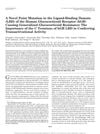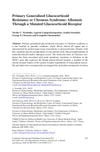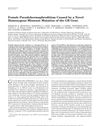Search
forLearn
3 / 3 resultslearn Stem Cell Factor
learn Osteopontin
signaling protein that, when suppressed, may grow hair by reducing inflammation and stem cell loss
Research
5 / 1000+ results
research A Novel Point Mutation in the Ligand-Binding Domain of the Human Glucocorticoid Receptor Causing Generalized Glucocorticoid Resistance: The Importance of the C Terminus in Conferring Transactivational Activity
A new mutation in the human glucocorticoid receptor reduces its function and causes resistance to glucocorticoids.
research Mandibulofacial Dysostosis With Alopecia Results From ETAR Gain-Of-Function Mutations Via Allosteric Effects On Ligand Binding
Specific mutations in a receptor cause facial abnormalities and hair loss.

research Primary Generalized Glucocorticoid Resistance or Chrousos Syndrome: Allostasis Through a Mutated Glucocorticoid Receptor
Chrousos Syndrome is caused by mutations that make the body less sensitive to glucocorticoids, leading to various symptoms and requiring high-dose treatment.

research Female Pseudohermaphroditism Caused by a Novel Homozygous Missense Mutation of the GR Gene
A new gene mutation causes female pseudohermaphroditism due to glucocorticoid resistance.
research Characterization of Type II Rickets Model Rats to Reveal Functions of Vitamin D and Vitamin D Receptor
The research showed that Vitamin D and its receptor are important for healthy bones and normal hair and skin in rats.
Community Join
5 / 22 resultscommunity Bile Acid-Mediated DHT Dysregulation Hypothesis
Elevated bile acids can inhibit the enzyme AKR1C2, leading to increased DHT levels, which may accelerate hair loss in those predisposed to androgenetic alopecia. Treatments mentioned include topical minoxidil and finasteride.
community Boys how is no one seeing positive results from pyrilutamide
Pyrilutimide, a treatment for hair loss; it's effectiveness compared to other treatments such as Finasteride and RU58841; and some users’ experiences with the treatment.
community Blaming Finasteride doesn't help you solve anything: dry eyes
Finasteride is debated for causing dry eyes, with some users experiencing relief after stopping it, while others find no connection. Topical treatments like dutasteride and minoxidil are suggested as alternatives, with advice to consult medical professionals.
community Fats on your Head to Stop Hair Loss?
The conversation discusses the potential of long-chain unsaturated fatty acids, like oleic and linoleic acid, as an additional treatment for hair loss, which may inhibit the enzyme responsible for converting testosterone to DHT and promote hair growth. Users humorously suggest using oils topically and discuss other hair loss treatments, but the main focus is on the science behind fatty acids and their role in hair health.
community Would Fluridil and Alfatradiol work effectively in conjunction with each other?
Whether using both Fluridil and Alfatradiol together could be more effective than either one alone as a hair loss treatment, given their different mechanisms of action.